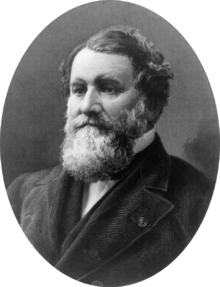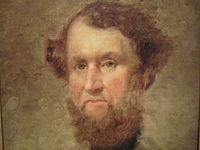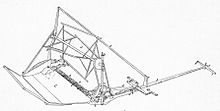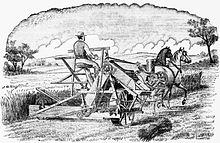- Cyrus McCormick
-
Cyrus Hall McCormick 
Born February 15, 1809
Rockbridge County, VirginiaDied May 13, 1884 (aged 75)
ChicagoKnown for International Harvester Net worth USD $10 million at the time of his death (approximately 1/1072nd of US GNP)[1] Spouse Nancy “Nettie” Fowler McCormick (m. 1835–1923) Children Cyrus Hall McCormick Jr.
Harold Fowler McCormick
(4 others)Parents Robert McCormick
Marry Ann HallRelatives Leander J. McCormick, brother
William Sanderson McCormick, brotherSignature 
Cyrus Hall McCormick, Sr. (1809–1884) was an American inventor and founder of the McCormick Harvesting Machine Company, which became part of International Harvester Company in 1902.[2] He and many members of the McCormick family became prominent Chicagoans. Although McCormick is often called the "inventor" of the mechanical reaper, it was based on work by others, including his family members[citation needed].
Contents
Early life
Cyrus Hall McCormick was born February 15, 1809 on the McCormick family farm known as Walnut Grove in Rockbridge County, Virginia, in the Shenandoah Valley on the western side of the Blue Ridge Mountains. His parents were Robert McCormick (1780–1846) and Mary Ann Hall McCormick (1780–1853),[3] both of whom were of Scots-Irish descent.[4]:17 He was the oldest of eight children, and had little or no formal education.[5]
Although the plantation kept some slaves, every family member was expected to help during harvest. From a young age, McCormick preferred using machines to save work in the fields. In his teens he devised a scythe cradle, and then patented plows that could be used on hillsides and sharpened themselves. His father kept a workshop to repair and build machines, such as those for mills on the property. McCormick tried to sell a hemp brake machine to farmers in Kentucky but made no sales.[5]
Reaper
McCormick's father purchased the original design from a blacksmith, by the name of McPhetrich.[6] As McCormick had some money and saw the potential of the design he applied for a patent for this to claim as his own, and worked for 28 years on a horse-drawn mechanical reaper to harvest grain. However, he was never able to duplicate a reliable version himself so his son took up the project.[3] A few machines based on a design of Patrick Bell in Scotland (which had not been patented) were available in the US. The Bell machine was pushed by horses. The McCormick design was pulled and cut the grain to one side. One of the first public demonstrations by McCormick of mechanical reaping was at the nearby village of Steeles Tavern, Virginia in 1831. McCormick claimed he developed a final version of the reaper in 18 months. The young McCormick was granted a patent on the reaper on June 21, 1834.[5]
This machine also did not work in many conditions, so none were sold. Instead, the McCormick family worked on starting a metal smelting business. The panic of 1837 almost caused the family to go into bankruptcy when a partner pulled out. In 1839 he started doing public demonstrations of the reaper, but local farmers still thought the machine was not reliable. He did sell one in 1840, but none for 1841. Using the endorsement of his Father's first customer that McPhetrich built, he continuously attempted to improve the design, seven reapers were sold in 1842, 29 in 1843, and 50 in 1844. They were all built manually in the family farm shop. He received a second patent for reaper improvements on January 31, 1845.[5]
A new city
Word kept spreading, and McCormick noticed orders were coming from farther west, where farms tended to be larger. While he was in Washington, DC to get his 1845 patent, he heard about a factory in Brockport, New York, where he contracted to have the machines mass-produced. In 1847 he and his brother Leander J. McCormick moved to Chicago, where they established a factory to build their machines. At the time, other cities in the midwestern United States such as Cleveland, Ohio, St. Louis, Missouri, or Milwaukee, Wisconsin were more prosperous. Chicago had no paved streets. However, Chicago offered water transportation from the east over the Great Lakes for his raw materials, as well as railroad connections to the farther west where his customers would be.[4]
When McCormick tried to renew his patent in 1848, the US Patent Office noted that a very similar machine had already been patented by Obed Hussey a few months earlier. McCormick then claimed he had really invented it in 1831, but the renewal was denied.[7] Another reaper patent had already been issued to William Manning of Plainfield, New Jersey in May 1831, but Manning was evidently not defending his patent.[5]
Brother William Sanderson McCormick moved to Chicago in 1849, and joined the company to take care of financial affairs. The McCormick reaper sold well, partially as a result of savvy and innovative business practices.[3] Their products came onto the market just as the development of railroads offered wide distribution to distant markets. He developed marketing and sales techniques, developing a vast network of trained salesmen able to demonstrate operation of the machines in the field. William H. Seward said of McCormick's invention that owing to it "the line of civilization moves westward thirty miles each year."[citation needed] A company advertisement was a take-off of the Westward the Course of Empire Takes Its Way mural by Emanuel Leutze adding to the title: “with McCormick Reapers in the Van."[8]
In 1851, McCormick traveled to London to display a reaper at the Crystal Palace Exhibition. He won a gold medal, but celebration was short-lived when he learned that he had lost a court challenge to Hussey's patent.[9]
McCormick-Manny Case
Another McCormick company competitor was the company of John Henry Manny of Rockford, Illinois. After the Manny Reaper beat the McCormick reaper at the Paris Exposition of 1855, McCormick filed a lawsuit against Manny for patent infringement.[10]
McCormick demanded that Manny stop producing reapers, and pay McCormick $400,000. The trial, originally scheduled for Chicago, Illinois in September 1855, had prominent lawyers on both sides. McCormick hired former US Attorney General Reverdy Johnson and New York patent attorney Edward Nicholl Dickerson. Manny hired George Harding and Edwin M. Stanton. Because the trial was set to take place in Illinois, Harding hired local Illinois lawyer Abraham Lincoln. However, the trial was moved to Cincinnati, Ohio. Although Manny won the case, with an opinion by Supreme Court Judge John McLean,[11] Lincoln ended up not contributing to the defense. Stanton had objected to Lincoln's presence, referring to him as "that damned long armed ape." After later being elected President, Lincoln chose Stanton as his Secretary of War.[12]
More controversy and success
In 1861, after Hussey's patent was extended but McCormick's was not, he convinced the US Congress to step in.[13]
In 1879 his brother Leander changed the name of the company from "Cyrus H. McCormick and Brothers" to "McCormick Harvesting Machine Company".[14] Leander wanted to clearly acknowledge contributions of others to the reaper "invention", especially their father. Cyrus' work was done with the help of Jo Anderson, a slave on the plantation at the time.[15]
Death and legacy
McCormick died in Chicago on May 13, 1884; he had been handicapped for the last four years of his life.[16] The official leadership of the company passed on to his son Cyrus Hall McCormick Jr. He was buried in Graceland Cemetery.[17] The McCormick factories were later the site of urban labor strikes that led to the Haymarket Square riot in 1886.
Cyrus McCormick's papers are held by the Wisconsin Historical Society.[2] Numerous prizes and medals were awarded for his reaper, and he was elected a corresponding member of the French Academy of Sciences, "as having done more for the cause of agriculture than any other living man." The invention of the reaper made farming far more efficient, and resulted in a global shift of labor from farmlands to cities.
A statue of McCormick is on the front campus of Washington and Lee University, Lexington, Virginia.
The town of McCormick, South Carolina and McCormick County were named for him after he bought a gold mine in the town, formerly known as Dornsville.[18]
McCormick was inducted into the Junior Achievement U.S. Business Hall of Fame in 1975.[19]
Family tree
On January 26, 1858 he married Nancy Fowler (1835–1923), better known as "Nettie".[20] They had seven children:
- Cyrus Hall McCormick Jr. was born May 16, 1859.
- Mary Virginia McCormick was born May 5, 1861.[20]
- Anita McCormick was born July 4, 1866, married Emmons Blaine on September 26, 1889, and died February 12, 1954. Her husband was the oldest son of US Secretary of State James G. Blaine.[21]
- Alice McCormick was born March 15, 1870 and died less than a year later on January 25, 1871.[20]
- Harold Fowler McCormick was born May 2, 1872, married and died in 1941.
- Stanley Robert McCormick was born November 2, 1874, married Katharine Dexter (1875–1967), and died January 19, 1947.
Mary Virginia and Stanley Robert both suffered from schizophrenia.[22] Stanley's life was dramatized in the 1998 novel Riven Rock by T. Coraghessan Boyle.[23]
He was the uncle of Robert Sanderson McCormick (son-in-law of Joseph Medill); granduncle of Joseph Medill McCormick and Robert Rutherford McCormick; great-granduncle of William McCormick Blair, Jr.[20]
Robert McCormick
(1780–1846)Mary Ann Hall
(1780–1853)Nancy Fowler McCormick
(1835–1923)Cyrus McCormick
(1809–1884)Mary Ann Grigsby
(1828–1878)William Sanderson McCormick
(1815–1865)Leander J. McCormick
(1819–1900)Cyrus McCormick Jr.
(1859–1936)Harold Fowler McCormick
(1872–1941)Joseph Medill
(1823–1899)L. Hamilton McCormick
(1859–1934)Robert Sanderson McCormick
(1849–1919)Kate Medill
(1853–1932)William Grigsby McCormick
(1851–1941)Ruby McCormick
(1860–1882)Joseph Medill McCormick
(1877–1925)Ruth Hanna McCormick
(1880–1944)Robert R. McCormick
(1880–1955)Chauncey Brooks McCormick
(1884–1954)William McCormick Blair
(1884–1982)Brooks McCormick
(1917–2006)William McCormick Blair, Jr.
(born 1916)References
- ^ Klepper, Michael; Gunther, Michael (1996), The Wealthy 100: From Benjamin Franklin to Bill Gates—A Ranking of the Richest Americans, Past and Present, Secaucus, New Jersey: Carol Publishing Group, p. xiii, ISBN 9780806518008, OCLC 33818143
- ^ a b "Cyrus Hall McCormick". Wisconsin Historical Society. http://www.wisconsinhistory.org/libraryarchives/ihc/cyrus.asp. Retrieved 2007-08-26. "Cyrus H. McCormick (1809-1884) was an industrialist and inventor of the first commercially successful reaper, a horse-drawn machine to harvest wheat. He was born at the family farm (Walnut Grove) in Rockbridge County, Virginia on February 15, 1809. His father Robert experimented with a design for a mechanical reaper from around the time of Cyrus' birth."
- ^ a b c Daniel Gross; Forbes Magazine Staff (August 1997). Greatest Business Stories of All Time (First ed.). New York: John Wiley & Sons. pp. 24–32. ISBN 0-471-19653-3.
- ^ a b Herbert Newton Casson (2009) [1909]. Cyrus Hall Mccormick: His Life and Work. BiblioBazaar, LLC. ISBN 1110232942. http://books.google.com/books?id=itgpAAAAYAAJ.
- ^ a b c d e George Iles (1912). "Cyrus H. McCormick". Leading American Inventors (2nd ed.). New York: Henry Holt and Company. pp. 276–314. http://www.archive.org/details/leadingamericani00ilesrich.
- ^ Cite error: Invalid
<ref>tag; no text was provided for refs namedMcPhetrich_Family_History; see Help:Cite errors/Cite error references no text - ^ Follet L. Green, ed (1912). Obed Hussey: Who, of All Inventors, Made Bread Cheap. The Rochester Herald publishing Company. http://books.google.com/books?id=eMhHAAAAIAAJ.
- ^ Michael Adas (2006). Dominance by design: technological imperatives and America's civilizing mission. Harvard University Press. p. 79. ISBN 9780674018679. http://books.google.com/books?id=yHh6gwshyKIC&pg=PA79.
- ^ "England: Closing of the Great Exhibition—The Ballon Hoax—Egyptian Railroad—Mr. McCormick's Reaping Machine" (PDF). New York Times. November 5, 1851. http://query.nytimes.com/mem/archive-free/pdf?res=F10B13FC3E5A147A8EDDAC0894D9415B8189F0D3. Retrieved January 18, 2011.
- ^ Sarah-Eva Carlson (February 1995). "Lincoln and the McCormick-Manny Case". Illinois History Magazine. http://www.lib.niu.edu/1995/ihy950230.html. Retrieved December 26, 2010.
- ^ John McLean (1856). "Cyrus H. McCormick v. John H. Manny and Others". Reports of cases argued and decided in the circuit court, Volume 6. H. W. Derby & Company. pp. 539–557. http://books.google.com/books?id=sCq3AAAAIAAJ&pg=PA539. U.S. District Court of Ohio record
- ^ Doris Kearns Goodwin (2005). Team of Rivals: The Political Genius of Abraham Lincoln. Simon and Schuster. pp. 173–175. ISBN 9780684824901. http://books.google.com/books?id=CqjBCWV6Eu4C&pg=PA173.
- ^ "The McCormick Reaper Patent". New York Times. July 6, 1861. http://www.nytimes.com/1861/07/06/news/the-mccormick-reaper-patent.html. Retrieved January 18, 2011.
- ^ "The McCormick Family and their Mechanical Reaper". Leander McCormick Observatory Museum. http://www.astro.virginia.edu/research/observatories/26inch/history/reaper.php. Retrieved December 28, 2010.
- ^ Patricia Carter Sluby (2004). The inventive spirit of African Americans: patented ingenuity. Greenwood Publishing Group. p. 282. ISBN 9780275966744. http://books.google.com/books?id=Wz-DTSXeLRYC&pg=PA282.
- ^ "Cyrus H. McCormick Dead" (PDF). New York Times. May 14, 1884,. http://query.nytimes.com/mem/archive-free/pdf?res=9907EED7113BE033A25757C1A9639C94659FD7CF. Retrieved 2007-08-21. "The Hon. Cyrus Hall McCormick died at his home in Chicago at 7 o'clock A.M. yesterday. He had been an invalid for the past three or four years, his troubles being caused by paralysis of the lower limbs. For two years he has not been able to walk..."
- ^ William Thomas Hutchinson (1935). Cyrus Hall McCormick: Harvest, 1856-1884. 2. New York: D. Appleton, The Century Company. http://www.archive.org/details/cyrushallmccormi000264mbp.
- ^ "History of Education in McCormick County". McCormick County School District. http://www.mccormick.k12.sc.us/History.html. Retrieved December 26, 2010.
- ^ "Cyrus H. McCormick". U.S. Business Hall of Fame Induction year 1975. Junior Achievement. http://www.ja.org/hof/viewLaureate.asp?id=107&induction_year=1975. Retrieved December 26, 2010.
- ^ a b c d Leander James McCormick (1896). Family record and biography. pp. 303–304. http://books.google.com/books?id=QC83AAAAMAAJ.
- ^ "Emmons Blaine Married; His Weddng with Miss Anita M'Cormick; Many Distinguished Guests Witnessed the Ceremonay at Richfield Springs Yesterday" (pdf). New York Times. September 27, 1889. http://query.nytimes.com/mem/archive-free/pdf?res=FB0C1EFC3F5E1A738DDDAE0A94D1405B8984F0D3. Retrieved January 5, 2011.
- ^ Miriam Kleiman (Summer 2007). "Rich, famous, and questionably sane: when a wealthy heir's family sought help from a hospital for the insane". Prologue: Quarterly of the National Archives and Records Administration 39 (2): 38–47. http://www.archives.gov/publications/prologue/2007/summer/mccormick.html.
- ^ T. Coraghessan Boyle. "Riven Rock". author's web page. http://www.tcboyle.com/page2.html?2,11. Retrieved December 29, 2010.
Further reading
- William Thomas Hutchinson (1935). Cyrus Hall McCormick: Harvest, 1856-1884. 2. New York: D. Appleton, The Century Company. http://www.archive.org/details/cyrushallmccormi000264mbp.
External links
- U.S. Patent X8,277 Improvement in Machines for Reaping Small Grain: Cyrus H. McCormick, June 21, 1834
- Farm Equipment on Antique Farming web site
- Cyrus McCormick at Encyclopædia Britannica
- Cyrus Hall McCormick at Find a Grave
- "McCormick-Guggenheim-Morton-Medill family of Illinois". The Political Graveyard. http://politicalgraveyard.com/families/10643.html. Retrieved January 1, 2011.
- "Our History". McCormick - Argo Tractors S.p.A.. http://www.mccormick-intl.com/mccormick/brand_page/en-US/8605/Our_History.aspx. Retrieved January 10, 2011.
- "Cyrus Hall McCormick". inventor profile. National Inventors Hall of Fame Foundation. http://www.invent.org/hall_of_fame/101.html. Retrieved January 10, 2011.
- McCormick Family Financial Records at Newberry Library
Categories:- 1809 births
- 1884 deaths
- American inventors
- 19th-century American newspaper publishers (people)
- Légion d'honneur recipients
- McCormick family
- National Inventors Hall of Fame inductees
- People from Chicago, Illinois
- American Presbyterians
- American people of Scotch-Irish descent
- Burials at Graceland Cemetery (Chicago)
- People from Rockbridge County, Virginia
Wikimedia Foundation. 2010.



